 Teacher Feature...
Teacher Feature...
Teachers.Net Teams with U.S. Coast Guard Operation Deep Freeze
by Kathleen Carpenter
Classroom teachers can sign up to communicate with South Pole Contingent
When U.S. Coast Guard Operation Deep Freeze goes to the South Pole to re-supply and support scientific research stations on the frozen continent, Teachers.Net readers will be part of the action. And individual classrooms throughout the United States have the opportunity to receive weekly messages and photos from aviators assigned to the operation. Teachers who sign up will be able to offer their students the unique and exciting opportunity to receive accounts and photos of the operation, e-mailed weekly to classrooms directly from Antarctica. Aviators will provide weekly updates, answer questions from students, and transmit digital photos from the icebound continent.
Following is information about Operation Deep Freeze and how teachers can become involved, supplied by Coast Guard Lt. Marshall Branch. Lt. Branch is the officer and helicopter pilot who will be coordinating the project with Teachers.Net and with classroom teachers who sign up to participate. He will also contribute articles about the activities of Operation Deep Freeze from Antarctica for Teachers.Net Gazette readers from approximately November 2002 through February 2003.
U. S. Coast Guard Polar Operations
Aviation Detachment (AVDET) 157 Prepares to Transit to Antarctica
by LT Marshall Branch
H-65 Pilot, AVDET 157
The U. S. Coast Guard has been actively involved in ice breaking operations since the turn of the century, an effort required to keep commerce lanes open on the Great Lakes, northern Atlantic, and Alaskan waters. In 1946, the Coast Guard Cutter NORTHWIND joined the venerable Admiral Richard Byrd in Operation High Jump, the largest Antarctic expedition in history. An aviation detachment aboard the NORTHWIND included a Sikorsky HNS-1 helicopter and a Grumman J2F-6 "Duck" airplane. The job of the aircraft was ice reconnaissance: to fly ahead of the ship and identify ice leads that would allow safest passage for the 11-ship fleet. Since that expedition, nearly 160 aviation detachments of mostly helicopters have joined Coast Guard Icebreakers in support of research to the extreme ends of the earth, underscoring the motto, "The WORLD is our operating area."
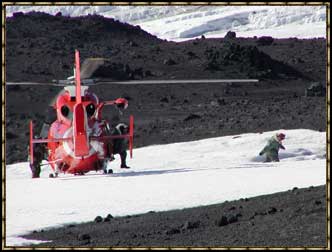
An H-65 "Dolphin" Helicopter landing at a remote site for the scientists to conduct research.
Starting in 1955, the Coast Guard has supported Operation Deep Freeze, the annual trip to support and resupply U.S. research stations at McMurdo, South Pole (Amundsen /Scott), Beaufort, Franklin, Cape Irizar, and Cape Roberts, Antarctica. Missing only the 1958 Deep Freeze (which was undertaken by the U.S. Navy ship GLACIER), Coast Guard icebreakers and their aviation detachments (AVDETís) have forded a path through 30-100 miles of frozen McMurdo Sound for cargo vessels delivering fuel, building supplies, provisions, and equipment to the 250 year-round and 1,500 seasonal residents of the frozen research facility. In addition, each icebreaker embarks up to 50 scientists from colleges and universities across America to conduct research aboard the vessels. Each vessel is fitted with multiple laboratories, sample collection equipment, and work spaces for the scientists to comfortably continue their studies. Their research is as varied as their university affiliations. Study of ice cores, plankton, seabed soil, weather and ocean current patterns, and polar wildlife are all projects undertaken on each deployment.
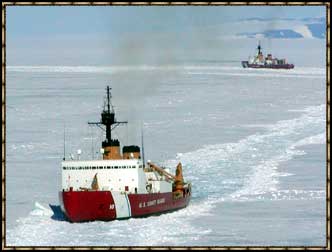
A photo of the POLAR SEA and the POLAR STAR breaking ice.
This November, AVDET 157 will depart the Coast Guard Aviation Training Center in Mobile, Alabama with two HH-65A "Dolphin" helicopters to accompany the Coast Guard Cutter POLAR SEA and 30-40 scientists from across America on their voyage to the southernmost continent. During this voyage, the helicopters will be used in the traditional role of ice scouting, but they will also be used to fly scientists to remote locations for their research, transfer equipment to isolated research encampments, and provide whatever logistical support the National Science Foundation requires.
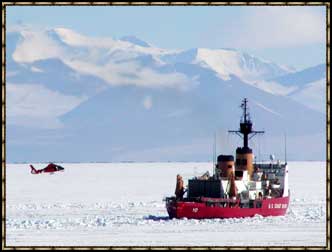
A photo of the H-65 landing aboard the POLAR SEA in Antarctica.
Aviation personnel operating in these extreme conditions receive extensive training in Cold Weather Survival, Mountain and Rough Area Operations, Helicopter and External Load Operations, and Shipboard Helicopter Operations. Additionally, since the AVDET is usually several thousand miles from the nearest maintenance facility, a $3.5 million helicopter support kit including spare parts for nearly every system on each aircraft is carried. Enlisted maintenance personnel are experts in their field and can generally respond to any maintenance need, a must when the ship is icebound in the lower latitudes.
The typical Operation Deep Freeze deployment lasts approximately six months, coinciding with the Antarctic Summer. The two HH-65A helicopters of AVDET 157 will depart Mobile, Alabama in late October and fly across the country to Seattle, Washington to meet the Coast Guard Cutter POLAR SEA. Once embarked, the aircrew will settle in to shipboard life and accompany the ship to Hawaii where the ship will onload additional equipment and supplies and undergo additional training for the long voyage. Once underway from Hawaii, it will take the POLAR SEA approximately one month before it arrives on station at McMurdo Point on Ross Island. En route, the crew will visit and service various navigation and automated research stations along the Antarctic coast and provide the scientists with bountiful opportunities to conduct their underway research. Once at McMurdo Sound, the helicopters will disembark the ship and land at McMurdo Station to work for the National Science Foundation. The POLAR SEA will then begin its long cut through the ice for the pier, sometimes meaning up to a 100 mile transit through thick Antarctic ice. Once at McMurdo, the ship will moor at the ice pier, using a technique called "shaving" to clean off jagged ice from the smoother face of the ice pier. This involves using the bow of the ship to actually "shave" off the ice that has formed on the pier since the last ship departed. If not done properly, the ship could actually chip large chunks from the ice pier itself.
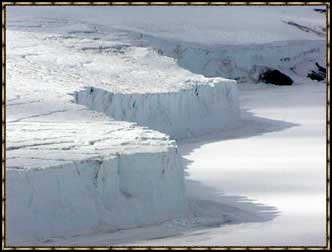
The Barne Glacier on Ross Island near Cape Evans
Once the AVDET is safely aboard McMurdo Station, the helicopters will fly multiple sorties transporting the scientists to all manner of remote locations to conduct their research. When they land at one of these remote locations, the aircrew often assists the scientists in setting up their equipment, obtaining samples, and recording their findings. This unique interaction between the scientists and the aircrews of the U. S. Coast Guard has facilitated strong bonds between the two communities.
The ship and AVDET should remain at McMurdo Station for approximately two to two and a half months before departing for the long journey home. Again, the voyage out will provide additional opportunities for underway research. The return trip to Seattle, Washington lasts nearly one month. Then the AVDET flies back across the country to greet family and friends in mid-April.
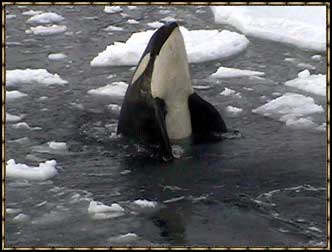
And a photo of an orca "spy-hopping" (that's how they look for food on the ice)
AVDET 157 welcomes the opportunity during this historic deployment to communicate with classrooms across the United States. Throughout the voyage, aviation personnel will correspond with schools that are interested in Operation Deep Freeze. Through the use of email, aircrew will be able to provide weekly updates, answer questions from students (keeping in mind that they are aircrew and not scientists themselves), and transmit digital photos of the frozen wonder of the icebound continent. Teachers that wish to participate can contact LT Marshall Branch of the USCG Polar Operations Division at jbranch@atc.uscg.mil for additional information. For additional information about the Polar Operations Division and the Aviation Detachments, view the POPDIV Website at www.uscg.mil/hq/atcmobil/popdiv/history.html
|

